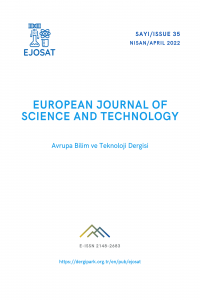Öz
Bu çalışmada artı şeklinde U tipli karma elektromıknatıs (kalıcı mıknatıs ve elektromıknatıs) kullanılarak yeni artı tip 4 kutuplu temassız taşıyıcı sistemi tasarlanmıştır. Artı tip elektromıknatıs için sonlu elemanlar metodu ile manyetik yastıklama kuvvetlerinin üç eksende (z,α,β) 3 boyutlu analizi ve elektromıknatısın manyetik eş değer devresi (MEC) çıkartılarak kuvvet analizleri gerçekleştirilmiştir. MEC ile elde edilen analitik model ile sonuçları karşılaştırılmıştır. Taşıyıcı sistemin, askılama işlemi yapıldığındaki nüvenin manyetik akı performansı incelenmiştir. Analitik hesaplamalar için Matlab programı, sonlu elemanlar analizi için ANSYS Maxwell-3D yazılımı kullanılmıştır.
Anahtar Kelimeler
Manyetik Yastık Maglev Taşıyıcı Sistemi Manyetik Eş Devre (MEC)
Destekleyen Kurum
TÜBİTAK
Proje Numarası
112M210
Teşekkür
Çalışmalarımıza desteklerinden dolayı TÜBİTAK ARDEB Başkanlığı’na, projemizi gerçekleme imkanı verdiği için YTÜ Rektörlüğü’ne, Mekatronik Mühendisliği Bölüm Başkanlığı’na teşekkür ederiz.
Kaynakça
- Atherton, D. (1980). Maglev Using Permanent Magnet. IEEE Transactions on Magnetics, (Vol.16, No: 1, Sf. 146–148.).
- Bozkurt, A.F., Güney, Ö.F., Erkan, K., (2018) Multi degrees of freedom robust magnetic levitation control of a flexible transport mover with disturbance observer and state feedback control, Control Engineering and Applied Informatics, 20(3):50-59.
- Erkan, K., Yalçın, B. C., Garip, M., , (2016). Three-axis gap clearance I-PD controller design based on coefficient diagram method for 4-pole hybrid electromagnet. Automatika: Journal for Control, Measurement, Electronics, Computing and Communications, 58:2, 147-167.
- Ertuğrul H.F., (2014). 4 kutuplu 3 Serbestlik dereceli karma elektromıknatısın modellenmesi ve kontrolü. [Yüksek lisans tezi, İstanbul Teknik Üniversitesi]
- Han, H. S., Kim D. S., (2016). Magnetic Levitation: Maglev Technology and Applications, Springer. https://doi.org/10.1007/978-94 017-7524-3.
- Kim, C., Lee, J., Han, H. ve Kim, B. (2011). Levitation and Thrust Control of a Maglev LCD Glass Conveyor. IECON 2011 - 37th Annual Conference on IEEE Industrial Electronics Society, Sf. 610 – 615.
- Lee, J., Khoo, S. and Wang, Z., (2013). DSP-Based Sliding-Mode Control for Electromagnetic-Levitation Precise-Position System, IEEE Transactions on Industrial Informatics, vol. 9, no. 2, pp. 817-827
- Morishita, M., Azukizawa, Teruo ; Kanda, S. ; Tamura, N. ; Yokoyama, T. (1989). A new Maglev System for Magnetically Levitated Carrier System. IEEE Transactions on Vehicular Technology, (Vol. 38, No: 4, Sf. 230 – 236.)
- Tzeng, Y. ve Wang, T. C. (1994). Optimal Design of the Electromagnetic Levitation with Permanent and Electro Magnets. IEEE Transactions on Magnetics, (Vol. 30, No. 6, Sf. 4731 – 4733.)
Öz
In this study, a new cross type 4-pole non-contact carrier system is created by using U-type hibrid electromagnets (permanent magnet and electromagnet). For the cross type electromagnet, 3-dimensional analysis of the magnetic levitation forces in three axes (z, α, β) was made with the finite element method and analytical calculations of the force analyzes were made by developing the magnetic equivalent circuit (MEC) of the electromagnet. The results were compared with the analytical model obtained with MEC. The magnetic flux performance of the core when the levitating process of the carrier system is performed has been investigated. Matlab program was used for analytical calculations and ANSYS Maxwell-3D software was used for finite element analysis.
Anahtar Kelimeler
Magnetic Levitation Maglev Carrier System Magnetic Equivalent Circuit (MEC)
Proje Numarası
112M210
Kaynakça
- Atherton, D. (1980). Maglev Using Permanent Magnet. IEEE Transactions on Magnetics, (Vol.16, No: 1, Sf. 146–148.).
- Bozkurt, A.F., Güney, Ö.F., Erkan, K., (2018) Multi degrees of freedom robust magnetic levitation control of a flexible transport mover with disturbance observer and state feedback control, Control Engineering and Applied Informatics, 20(3):50-59.
- Erkan, K., Yalçın, B. C., Garip, M., , (2016). Three-axis gap clearance I-PD controller design based on coefficient diagram method for 4-pole hybrid electromagnet. Automatika: Journal for Control, Measurement, Electronics, Computing and Communications, 58:2, 147-167.
- Ertuğrul H.F., (2014). 4 kutuplu 3 Serbestlik dereceli karma elektromıknatısın modellenmesi ve kontrolü. [Yüksek lisans tezi, İstanbul Teknik Üniversitesi]
- Han, H. S., Kim D. S., (2016). Magnetic Levitation: Maglev Technology and Applications, Springer. https://doi.org/10.1007/978-94 017-7524-3.
- Kim, C., Lee, J., Han, H. ve Kim, B. (2011). Levitation and Thrust Control of a Maglev LCD Glass Conveyor. IECON 2011 - 37th Annual Conference on IEEE Industrial Electronics Society, Sf. 610 – 615.
- Lee, J., Khoo, S. and Wang, Z., (2013). DSP-Based Sliding-Mode Control for Electromagnetic-Levitation Precise-Position System, IEEE Transactions on Industrial Informatics, vol. 9, no. 2, pp. 817-827
- Morishita, M., Azukizawa, Teruo ; Kanda, S. ; Tamura, N. ; Yokoyama, T. (1989). A new Maglev System for Magnetically Levitated Carrier System. IEEE Transactions on Vehicular Technology, (Vol. 38, No: 4, Sf. 230 – 236.)
- Tzeng, Y. ve Wang, T. C. (1994). Optimal Design of the Electromagnetic Levitation with Permanent and Electro Magnets. IEEE Transactions on Magnetics, (Vol. 30, No. 6, Sf. 4731 – 4733.)
Ayrıntılar
| Birincil Dil | Türkçe |
|---|---|
| Konular | Mühendislik |
| Bölüm | Makaleler |
| Yazarlar | |
| Proje Numarası | 112M210 |
| Yayımlanma Tarihi | 7 Mayıs 2022 |
| Yayımlandığı Sayı | Yıl 2022 Sayı: 35 |


